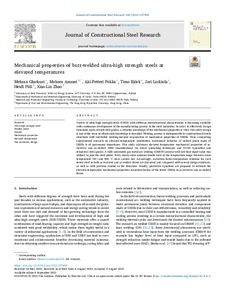Mechanical properties of butt-welded ultra-high strength steels at elevated temperatures
Ghafouri Mehran; Amraei Mohsen; Pokka Aki-Petteri; Björk Timo; Larkiola Jari; Piili Heidi; Zhao Xiao-Lin
https://urn.fi/URN:NBN:fi-fe2022102463129
Tiivistelmä
Variety of ultra-high strength steels (UHSS) with different microstructural characteristics is becoming available with continuous development of the manufacturing process in the steel industries. In order to effectively design structures made of such steel grades, a detailed knowledge of the mechanical properties is vital. Fire safety design is one of the areas in which such knowledge is essential. Welding process is indispensable in construction of steels structures with inevitable welding-induced degradation of mechanical properties of UHSSs. Thus, conducting experimental research on elevated-temperature constitutive mechanical behavior of welded joints made of UHSSs is of paramount importance. This study addresses elevated-temperature mechanical properties of as-received and as-welded S960 (manufactured via direct quenching technique) and S1100 (quenched and tempered) steel grades. A fully automated gas metal arc welding (GMAW) process with low heat input value was utilized to join the steel plates. Next, steady-state uniaxial tensile tests in the temperature range between room temperature (RT) and 900 °C were carried out. Accordingly, reduction factor-temperature relations for each tested steel in both as-received and as-welded forms are discussed and compared with several design standards, as well as with previous studies in the literature. Finally, predictive equations are proposed to estimate the elevated-temperature mechanical properties reduction factors of the tested UHSSs in as-received and as-welded forms.
Kokoelmat
- Rinnakkaistallenteet [27094]
